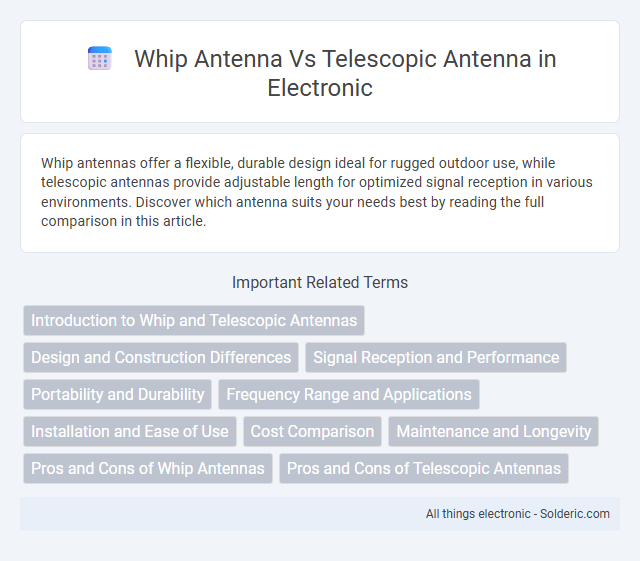Whip antennas offer a flexible, durable design ideal for rugged outdoor use, while telescopic antennas provide adjustable length for optimized signal reception in various environments. Discover which antenna suits your needs best by reading the full comparison in this article.
Comparison Table
| Feature | Whip Antenna | Telescopic Antenna |
|---|---|---|
| Design | Fixed, flexible rod | Extendable, multi-segment |
| Length | Permanent, fixed length | Adjustable length, variable |
| Portability | Less portable, fixed size | Highly portable, compact when collapsed |
| Durability | Robust and sturdy | More prone to wear, delicate joints |
| Tuning | Limited tuning, fixed length | Easier tuning via length adjustment |
| Usage | Vehicle, base stations | Portable radios, handheld devices |
Introduction to Whip and Telescopic Antennas
Whip antennas feature a flexible, single rod design ideal for mobile communication and durable performance in various environments. Telescopic antennas consist of extendable metal sections, allowing adjustable length to optimize signal reception for handheld radios and portable devices. Your choice depends on the balance between portability, signal range, and durability requirements for your specific application.
Design and Construction Differences
Whip antennas feature a flexible, single-piece wire or rod design often mounted vertically, providing durability and ease of installation. Telescopic antennas consist of multiple nested metal sections that can extend or retract, allowing adjustable length for optimal signal reception. The telescopic design offers versatility in length adjustment, while whip antennas prioritize robustness and simplicity in construction.
Signal Reception and Performance
Whip antennas typically offer robust signal reception due to their fixed length and sturdy design, providing consistent performance in various environments. Telescopic antennas excel in adjustable signal reception, allowing you to extend or retract the antenna length to optimize performance based on your specific frequency needs. Both antenna types impact your device's connectivity, but telescopic antennas give more flexibility for fine-tuning signal strength in dynamic conditions.
Portability and Durability
Whip antennas offer superior durability due to their flexible, rugged design, making them ideal for rough outdoor environments and frequent handling. Telescopic antennas excel in portability because they can collapse into a compact form, facilitating easy storage and transport. Choosing between the two depends on whether impact resistance or space-saving convenience is prioritized.
Frequency Range and Applications
Whip antennas typically operate within VHF and UHF frequency ranges, making them ideal for mobile communication, broadcasting, and two-way radio applications. Telescopic antennas offer adjustable length, allowing better tuning across a wider frequency spectrum from HF to VHF bands, which suits portable radios and scanners requiring versatile performance. Both antenna types are favored for their specific frequency adaptability, influencing their use in vehicle communication systems versus handheld devices.
Installation and Ease of Use
Whip antennas offer straightforward installation with flexible mounting options, making them ideal for fixed or mobile setups requiring minimal adjustment. Telescopic antennas provide versatile length adjustment for optimizing signal reception but may require more careful handling during setup to avoid damage. Your choice depends on whether you prioritize quick, durable installation or fine-tuned control over antenna length for varying signal conditions.
Cost Comparison
Whip antennas generally offer a lower cost compared to telescopic antennas due to their simpler design and fewer moving parts. Telescopic antennas tend to be more expensive because of their extendable segments and mechanical components, which provide greater flexibility and range adjustments. Your choice may depend on balancing budget constraints with the desired antenna functionality for your specific application.
Maintenance and Longevity
Whip antennas require minimal maintenance due to their flexible design, which helps absorb impacts and reduces the risk of damage, resulting in extended longevity. Telescopic antennas, while adjustable for length and frequency tuning, often demand regular cleaning and careful handling to prevent joint corrosion and mechanical wear, which can shorten their lifespan. Selecting a whip antenna is preferable for environments where durability and low maintenance are critical, whereas telescopic antennas suit applications needing frequent length adjustments but involve more upkeep.
Pros and Cons of Whip Antennas
Whip antennas offer flexible design and durability with a simple, lightweight construction, making them ideal for mobile communication devices and vehicles. Their main drawbacks include limited range and lower signal gain compared to telescopic antennas, which can be extended for better reception. Your choice depends on whether you prioritize portability and ease of installation over maximum signal performance.
Pros and Cons of Telescopic Antennas
Telescopic antennas offer adjustable length, enabling improved signal reception for various frequencies, making them versatile for radios and portable devices. Their compact, retractable design enhances portability and storage convenience but may lack durability compared to fixed whip antennas due to potential mechanical wear. You benefit from fine-tuning signal strength with telescopic antennas, though they require careful handling to avoid damage and maintain optimal performance.
whip antenna vs telescopic antenna Infographic

 solderic.com
solderic.com